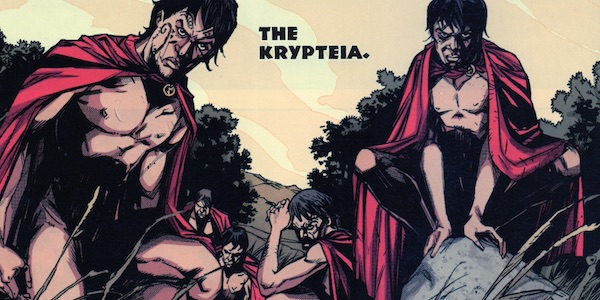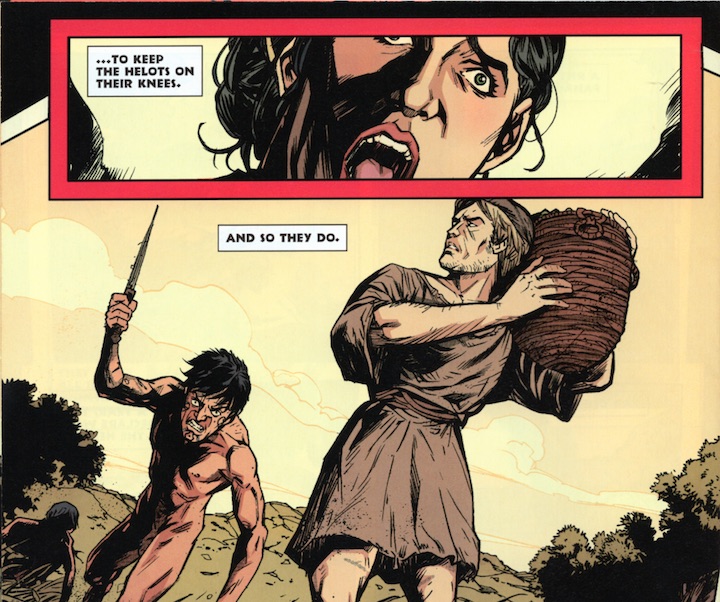
August 4, 2020, by Lynn Fotheringham
The Krypteia, part 1
Three, by Kieron Gillen & Ryan Kelly; chapter/issue 1, cont. [For an introduction to Three, see this post.]
CONTENT: ANCIENT SLAVERY, MURDER OF THE ENSLAVED, EXTREME (& NON-MILITARY) VIOLENCE, IMAGES IMPLYING VIOLENCE
I started this series of comparisons between Three and its sources by jumping in to the main story and skipping the ‘prologue’. I think I wanted to begin with something less emotionally charged… The prologue is designed to establish the dark side of the heroic Sparta that is all many readers will be familiar with; to do this it needs to be brutal.
Here a young Spartiate man moves to attack a Helot man harvesting olives; a Helot woman looks on in horror. The captions appearing on these panels are part of a longer sequence:
So they are free to do whatever is required…
… to keep the Helots on their knees.
And so they do.
The strongest are purged.
The rest are cowed.

THREE ch.1, p.4 panels 1-2
The violent irruption into the Helots’ lives is reflected in Ryan Kelly’s layout, with the main panel coming detached from the usual right-angle grid. The smaller panel set in parallel with the page-edge emphasises the change, and Jordie Bellaire’s decision to colour the border of the smaller panel in red also contributes to the sense of menace.
The young Spartiates carrying out this institutionalised murder of Helots are referred to as the krypteia/krupteia/crypteia (depending on how the Greek letters upsilon and kappa are transliterated). The word derives from kruptein, meaning ‘to hide’, and is sometimes translated ‘secret service’. In the comic, Kieron follows closely the account given in Plutarch’s Life of Lycurgus (late first/early second century C.E.), which seems to go back to a lost work of Aristotle (writing in the fourth century B.C.E.):
28. (1) ἡ δὲ καλουμένη κρυπτεία … (2) ἦν δὲ τοιαύτη· τῶν νέων οἱ ἄρχοντες διὰ χρόνου τοὺς μάλιστα νοῦν ἔχειν δοκοῦντας εἰς τὴν χώραν ἄλλως ἐξέπεμπον, ἔχοντας ἐγχειρίδια καὶ τροφὴν ἀναγκαίαν, ἄλλο δὲ οὐδέν· οἱ δὲ μεθ᾿ ἡμέραν μὲν εἰς ἀσυνδήλους διασπειρόμενοι τόπους, ἀπέκρυπτον ἑαυτοὺς καὶ ἀνεπαύοντο, (3) νύκτωρ δὲ κατιόντες εἰς τὰς ὁδοὺς τῶν εἱλώτων τὸν ἁλισκόμενον ἀπέσφαττον. πολλάκις δὲ καὶ τοῖς ἀγροῖς ἐπιπορευόμενοι τοὺς ῥωμαλεωτάτους καὶ κρατίστους αὐτῶν ἀνῄρουν. |
28. (1) The so-called “krupteia,” or secret service, … (2) was of the following nature. The magistrates from time to time sent out into the country at large the most discreet of the young warriors, equipped only with daggers and such supplies as were necessary. In the day time they scattered into obscure and out of the way places, where they hid themselves and lay quiet; (3) but in the night they came down into the highways and killed every Helot whom they caught. Oftentimes, too, they actually traversed the fields where Helots were working and slew the sturdiest and best of them. |
- Text and translation by Bernadotte Perrin, Loeb Classical Library vol. 46, 1914.
Plutarch is not the only source that Kieron took into account in his presentation of the krypteia. The next post will look at evidence provided by Plato and share some of the discussion between Kieron and historical consultant Stephen Hodkinson about this Spartan institution – which, like all Spartan institutions, is reported to us by outsiders.
One reason for postponing the discussion of Plato is to keep the length of individual posts down. But I also wanted to leave the horrific image taken from Plutarch undiluted for a moment. Plutarch is one of our major sources for Spartan life, and however positive his attitude to Sparta as whole, he reports some cruel and brutal behaviour. (He himself argues that the krypteia cannot have been instituted by his hero Lycurgus.) For those of you who haven’t read Three, the violence implied in the panels shown here is only the beginning; the prologue ends with a grimly striking splash-page showing a Helot’s-eye-view of the Spartiates’ descending knives.
For bibliography on the krypteia, see next post.
NOTE: I may refer to/quote comments on this post either in later blog-posts or in a research publication. More information about my audience-research, including a Privacy Notice and ways of getting hold of the book.
Extracts from Three © 2013 Kieron Gillen & Ryan Kelly. Used with permission.
No comments yet, fill out a comment to be the first

Leave a Reply